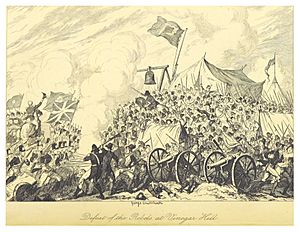Irish rebellion of 1798 facts for kids
Quick facts for kids United Irishmen Rebellion (1798) |
|||||||
|---|---|---|---|---|---|---|---|
 Defeat of the Rebels at Vinegar Hill, by George Cruikshank |
|||||||
|
|||||||
| Belligerents | |||||||
| Commanders and leaders | |||||||
John Murphy |
|||||||
| Strength | |||||||
| 50,000 United Irishmen 4,100 French regulars 10 French Navy ships |
40,000 militia 30,000 British regulars ~25,000 yeomanry ~1,000 Hessians |
||||||
| Casualties and losses | |||||||
|
10,000–50,000 estimated combatant and civilian deaths
3,500 French captured7 French ships captured |
c.500–2,000 military deaths
c.1,000 loyalist civilian deaths |
||||||
The Irish Rebellion of 1798 was a big uprising against British rule in Ireland. It happened from May to September 1798. The main group behind it was called the United Irishmen. They were a revolutionary group who wanted Ireland to be a republic, meaning a country governed by its people, not a king. Their ideas were inspired by the American Revolution and the French Revolution.
Contents
Why the Rebellion Started
For a long time, Ireland was mostly controlled by a group of wealthy Protestants. They ruled on behalf of the British King. Most people in Ireland were Catholic, and they faced unfair laws called the Penal Laws. These laws limited what Catholics could do, like owning land or holding public jobs.
As time went on, some people, including some Protestants, wanted things to change. They were inspired by the American Revolution, where the American colonies fought for their freedom. These people wanted more fairness and more control over Ireland's own government, separate from Britain.
The Plan for the Uprising
The United Irishmen planned to start their rebellion by taking over Dublin, the capital city. After that, counties around Dublin would rise up to stop British soldiers from reaching the city. Then, the rest of the country would join in.
However, the British government found out about the plan from spies. They quickly sent soldiers to the places where the rebels were supposed to meet in Dublin. This stopped the main part of the rebellion before it even began in the capital.
Even though the Dublin plan failed, the counties around Dublin still rose up as planned. The fighting began on May 24th, especially in Wicklow, Meath, and Kildare.
Key Battles and Defeats
The signal for the rebellion to spread was supposed to be when mail coaches from Dublin were stopped. One coach going to Munster was stopped near Naas, and the passengers were killed.
The British government managed to win most of the early battles. Rebel forces suffered big defeats in places like Carlow and Tara Hill. These losses quickly ended the rebellion in those areas. News of the uprising caused a lot of fear. British forces sometimes killed suspected rebels in places like Dunlavin Green and Carnew.
What Happened After
Even after the main rebellion was defeated, some small groups of rebels kept fighting. The last rebel group, led by James Corocoran, was not defeated until February 1804. In Wicklow, some rebels continued to fight like guerrillas (small groups using surprise attacks).
However, when another rebellion attempt by Robert Emmet failed in 1803, the last organized rebel forces, led by Michael Dwyer, finally agreed to surrender in 1804. The rebellion's defeat led to the Act of Union (1800), which joined Ireland directly with Great Britain, creating the United Kingdom.
Images for kids
-
Belfast physician William Drennan, who helped form the United Irish organisation.
-
Defeat of the Rebels at Vinegar Hill, by George Cruikshank.
-
The Battle of Castlebar, 1798.
-
General Joseph Holt (1799).
-
The last stand of James Corcoran (11 February 1804).
-
The grave of Wolfe Tone in Bodenstown, County Kildare.
-
"Pikeman" statue in Wexford Town.
See also
 In Spanish: Rebelión irlandesa de 1798 para niños
In Spanish: Rebelión irlandesa de 1798 para niños













